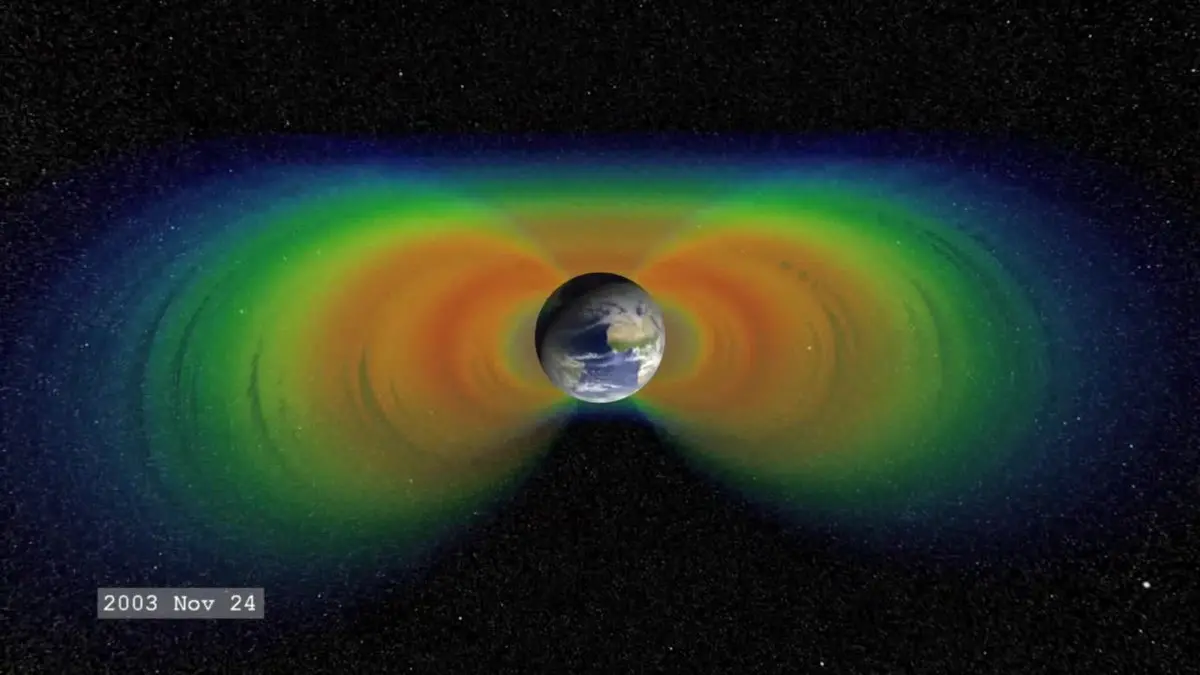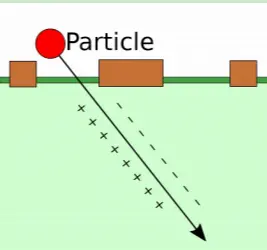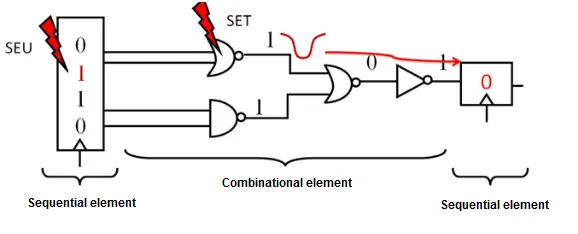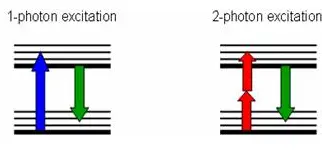Understanding the Single Event Effect (SEE)
Space-borne instruments carry many electronic devices, including microprocessors, digital registers, etc. If a charged particle from space strikes a sensitive node of an electronic circuit, it may cause a disruption or permanent damage. This article intends to explain this issue. Our sun emits a large number of charged and uncharged particles, including protons, heavy ions, and neutrons. Aside from that, there is a constant stream of charged particles from cosmic rays that bombard the Earth. Many of these charged particles get trapped in the Earth’s magnetic field and continuously circle the planet. The Earth’s Van Allen Belt, which traps these charged particles, is shown in Figure 1

Figure 1: Earth’s Van Allen Belt (Wikipedia picture)
As depicted in the figure, the Earth’s magnetic field is slightly offset from the planet’s axis, and the Van Allen belt consists of an inner belt and an outer belt. In addition, neutrons reaching Earth's surface could collide with an atom and produce a destructive secondary charged particle [Reference 1]. If necessary precautions, such as shielding, are not taken for space instruments, a charged particle striking a sensitive node of the circuit could inflict temporary or permanent damage. These harmful effects on electronic circuits can be classified under a phenomenon called “Single Effect Event (SEE) which can be further divided into sub-categories as follows:
● Single Event Upset (SEU): A transient effect, affecting mainly memories
● Single Event Transient (SET): A temporary pulse traverses the circuit. Nothing can be done about it
● Single Event Latchup (SEL): Can destroy the component , affecting mainly CMOS
● Single Event Gate Rupture (SEGR): Potentially destructive, affecting sub-micron structure
● Single Effect Breakdown (SEB): Has a destructive impact, affecting mainly the power MOSFET
Some of these effects are only disruptive, such as SEU and SET, and some others can permanently destroy a circuit, such as SEL. SEGR and SEB.
Circuit quality control testing is required prior to the launch of space instruments to identify sensitive nodes and protect against charged-particle strikes.
Figure 2 shows a charged particle striking an electronic circuit and creating electron-hole pairs along its path.

Figure 2: Charged particle striking an integrated circuit and creating electron-hole pairs along its path
When the charged particle hits as shown in Figure 3, sequential elements such as shift registers can be disrupted by SEU, causing a flipped bit (shown in red), and combinational elements such as AND/OR gates can be affected by a SET, which can in turn upset another sequential element further ahead.

Figure 3: Effect of SEU and SET on sequential and combinational elements in an integrated circuit [Reference 2]
To protect against these charged particles, integrated circuits can be hard-coated, or additional substrates such as Silicon on Sapphire (SOS) or Silicon On Insulator (SOI) can be useTo protect against these charged particles, integrated circuits can be hard-coated, or additional substrates such as Silicon on Sapphire (SOS) or Silicon On Insulator (SOI) can be used. However, since some nodes in the circuit are more sensitive than others, testing needs to be done before launch of the space instrument to identify which nodes are sensitive, or to verify that the implemented radiation-hardening has been sufficient to protect the integrated circuit against intense radiation. Radiation testing can be performed either in a particle accelerator, such as a synchrotron or a cyclotron, where charged particles are accelerated to simulate the energy of solar or cosmic particles, or using ultrashort, pico- or nano-joule energy pulsed lasers. The particle accelerator method is more realistic of the actual situation, but suffers from several drawbacks, including high cost and the possibility of inflicting permanent damage to the circuit. The optical method is easier to set up and is less expensive, but it has several drawbacks. These drawbacks include the inability of optical radiation to penetrate metal and to measure the SEE threshold [Reference 3]. Figure 4 shows the optical beam penetrating the non-metal part of an integrated circuit and generating electron-hole pairs along the way.

Figure 4: The penetration of a pulsed laser into the integrated circuit and the generation of electron-hole pairs initiating the Single Event effect (SEE)
For optical testing, a near-IR laser with a few-kHz repetition rate, picojoule/nanojoule pulse energy, and pulse widths of hundreds of femtoseconds to one picosecond is typically used. Using a sensitive microscope, a sensitive CCD and an InGaAs camera, and a very sensitive positional stage, it is possible to determine the locations of the sensitive spots. Some advantages and drawbacks of the optical method were briefly mentioned earlier, but some others are mentioned in detail as follows:
● The optical method is restricted by the diffraction limit as far as the focused size of the beam is concerned. For a 1064 nm near-IR beam, the diffraction limit is about 1 micron and must be taken into account.
● Lasers can focus on the device, specifically on the IC chip, with sub-micron resolution.
● The optical method is easy to set up anywhere in a lab, as opposed to the radiation method, which requires an expensive trip to a specific accelerator facility, which could be far away.
● The optical technique is perfect for Commercial Off-The-Shelf (COTS) sorting or pre-screening.
Although the optical technique was compared to the radiation technique, it is necessary to emphasize that it is not meant to replace it. Instead, the optical method is meant to complement the radiation method. As mentioned earlier, the optical method cannot measure the absolute upset threshold, but the laser upset threshold can be compared with the ion-beam upset threshold. It is assumed that the relative differences remain constant throughout the measurements, and hence all subsequent measurements can be performed with the laser [Reference 4]. Calibration of the optical method against the radiation method, along with the correlation between the two methods, will be addressed in a future tech note.
Another factor that needs to be addressed in the optical testing is the possibility of Two-Photon Absorption (TPA) rather than Single-Photon Absorption (SPA). If the energy of the striking radiation is greater than the band gap of silicon (1.1 eV), then SPA will occur. However, if the photon energy is slightly greater than half the bandgap (~0.55 eV), it is possible for two photons to be absorbed and trigger the SEE. The wavelength corresponding to the bandgap of silicon is 1127 nm, and hence, for two-photon absorption, the wavelength of the laser needs to be larger than this wavelength. TPA is a nonlinear process, and the probability of its occurrence is much lower than that of SPA. However, it has the advantage of unlimited penetration depth and well-deposited energy in the focal zone due to non-linear absorption. Figure 5 shows the TPA process and its comparison with SPA.

Figure 5: Comparison of SPA and TPA
Allied Scientific Pro has designed a SEE Testing System that uses an NIR laser and sensitive SWIR cameras. In addition, there is a very sensitive positioning stage and a microscope objective that allows the beam to move around the integrated circuit by submicron distances. Figure 6 shows this test system.

Figure 6: Asp’s SEE Testing System
The system uses Kohler illumination for high contrast shadow-free imaging and an imaging system with greater than 1.5 megapixels for front-side and back-side illumination.
References
1 - Jeffry Wyss, neutrons for radiation hardness studies, neutron-induced single event effects, November 2009.
2 - Fernanda Lima Kastensmidt, SEE mitigation for digital circuit design applicable to ASIC and FPGAs, online presentation.
3 - Feng Liang and Steeve Lavoie, 2 Photons; Workstation for Laser Testing of Single Events Effects (SEE) on Radiation Hardened Semiconductor Devices
4 - Stephen Buchner, laser simulation of Single Event Effects: A state of the art review, 1995.